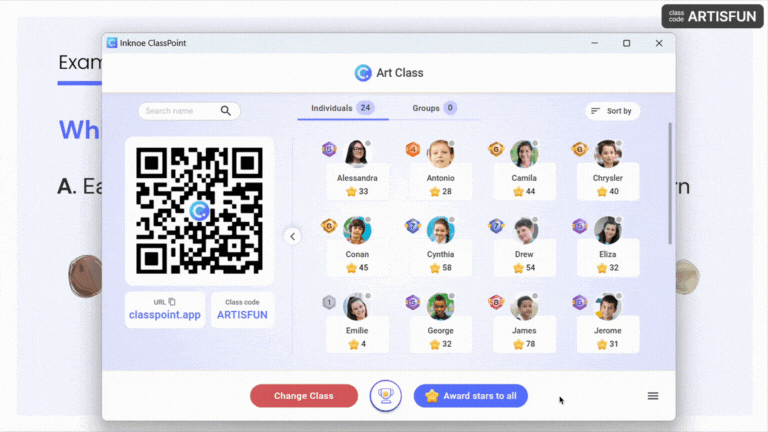Students are most engaged when learning feels playful. The classroom atmosphere changes and student participation comes more easily.
Classroom gamification takes that same spirit and builds it into daily lessons. With the right strategies, simple activities can feel exciting and rewarding.
Teachers have always found ways to motivate students. What has changed is how gamification can now be tied closely to learning goals, turning everyday routines into opportunities for progress.
When you begin gamifying your classroom, students notice their growth. They stay motivated longer and often support one another more.
This guide shares practical ways on how to gamify your classroom. The steps are clear and easy to try with the tools you already use. At the end, you will also see how ClassPoint can extend these strategies inside PowerPoint without adding extra work.
1. Give points for specific classroom behaviors
Points work best when students know exactly what they are working toward. Instead of just saying “participation,” decide which behaviors you want to see more of and make those count for points. This way, students know what actions matter and they will repeat them.
Keep the system simple and consistent. The clearer the rule, the easier it is for students to understand what earns recognition. Over time, these small actions build strong habits that carry through the whole class.
| Example behavior | Points earned | Reward for | Best used when |
|---|---|---|---|
| Asking a thoughtful question | 5 points | Critical thinking | Class discussions or Q&A |
| Helping a peer without being asked | 3 points | Collaboration | Group projects |
| Submitting homework on time | 2 points | Responsibility | Daily routines |
| Sharing a creative solution | 4 points | Innovation | Problem-solving activities |
To better hone student behavior in the classroom, here are Actionable Tips and Tools for Interactive Classroom Behavior Management.
2. Make an interactive scoreboard
Once points are in place, students need to see them. A scoreboard makes progress clear and motivates everyone. It turns the idea of points into something the class can follow together.
A scoreboard is more powerful when students take part in it. Instead of you keeping track in the background, let them update and add to it. This gives the scoreboard life and makes it part of the classroom routine.
Ways to make your scoreboard interactive:
- Invite students to place their own stars or stickers.
- Choose a student helper each day to update the chart.
- Project a slide with team icons that students move forward when they earn points.
- Change the focus sometimes between individual and group scores to keep everyone involved.
3. Turn boring tasks into quick challenges

Routine work can feel heavy for students. Gamification helps by changing the way the task is presented. A worksheet, a set of notes, or a review question can turn into a challenge that sparks interest.
The shift does not need to be big. By giving the task a goal or adding a playful twist, the same work feels lighter and students respond with more effort.
Examples of turning tasks into challenges:
- Copy notes → Aim to finish neatly with no mistakes
- Complete a worksheet → Solve as many questions as you can in five minutes for bonus points
- Answer review questions → Play them out as a trivia round with teams
- Read a passage → Find and highlight key words as if you were on a scavenger hunt
4. Use timed rounds to add urgency
A timer can change the pace of a lesson in seconds. By setting a short period of time for a task, you create focus and energy. Students often respond faster and put in more effort when they know the clock is running.
This method works best in small bursts. A two minute math sprint, a one minute vocabulary list, or a quick-fire round of history questions are all simple ways to add urgency without pressure. The key is to keep the activity short and achievable.
You can use the timer on your phone, a slide animation, or a simple stopwatch. The tool does not matter as much as the fact that students can see the time passing. The countdown itself is what makes them lean in and try harder.
Look no further. We've created a list of Best Free Online Classroom Timer Tools Every Teacher Must Know!
5. Use levels to differentiate learning depth
Levels are one of the easiest ways to move beyond surface rewards and bring more depth into a gamified classroom. A simple structure with multiple levels lets students decide whether to stick with the basics or challenge themselves further. This makes gamifying your classroom flexible enough to reach both struggling and advanced learners.
Each level should connect to the type of thinking you want. Start with recall, move into applying knowledge, and finish with analysis or creation. Over time, encourage students to climb higher.
| Level | Task type | Example in class |
|---|---|---|
| Level 1 | Recall | List the planets in the solar system |
| Level 2 | Apply | Explain why Mars has a longer year than Earth |
| Level 3 | Analyze or create | Design a simple mission plan for Mars |
6. Design badges around soft skills
Badges are often linked to top scores, but classroom gamification works best when it rewards a wider set of skills. Creativity, teamwork, and persistence are just as valuable as correct answers. By designing badges for these, you make a gamified classroom that celebrates growth and effort, not just results.
Badges can be paper, stickers, or digital icons. What matters is that they feel earned and specific. This is a small but powerful way to gamify your classroom while giving more students a chance to succeed.
Some examples of soft-skill badges teachers find useful:
- Most improved for steady progress over time
- Best teammate for helping peers and contributing in groups
- Creative solution for thinking of new approaches to a task
7. Turn review into recognizable game formats
Review sessions are where gamifying your classroom can shine. Instead of checking answers in the usual way, bring in structures students already know from popular games. The shift is small, but the engagement it creates is much higher.
Teachers who build classroom gamification into review see that it changes the pace and keeps attention longer. You do not need elaborate setups to make it work.
Explore creative ideas with our curated list of Low-Prep Classroom Review Games Your Students Will Surely Love!
8. Use randomizers to keep it fair and exciting
Randomizers bring both fairness and surprise into a gamified classroom. Students who are quieter or slower to raise their hand get equal chances, and everyone pays closer attention because no one knows who or what is coming next. This is one of the simplest ways to gamify your classroom without heavy preparation.
Here are some classroom-ready examples:
- Write names on slips of paper and draw one each time you need a response
- Roll a dice after a correct answer to see if it is worth one, three, or six points
- Spin a wheel with categories like “bonus question,” “switch teams,” or “double points”
Random chance keeps energy high and makes classroom gamification feel more like a real game.
Choosing the right classroom randomizer can be overwhelming with so many options available. Here's a list of Tried and Tested Random Name Pickers for Teachers.
How to Gamify Your Classroom in PowerPoint
Now that you have a set of practical ways to gamify your classroom, the question is how to make these ideas easy to manage every day. Most teachers already use PowerPoint to deliver their lessons, which makes it the perfect place to build a gamified classroom. Instead of juggling different apps or adding more prep work, you can keep everything in the same tool you already know.
ClassPoint works as a reliable ally. It goes beyond being interactive as it brings gamification directly into your slides so you can apply the strategies we covered without leaving your lesson flow.

Here are the gamification highlights that matter most for teachers:
- Stars and points given in real time with progress saved across lessons, so students build recognition over days or weeks instead of starting fresh every time
- Levels that grow from earned stars, showing students exactly how their effort accumulates and how far they have advanced
- Badges that spotlight different strengths, including collaboration, creativity, and improvement, not just correct answers
- Leaderboards that can be revealed anytime, whether at the end of a lesson or a unit, with the option to reset or continue depending on your teaching goals
- Name Picker that keeps participation fair and exciting, giving every student an equal chance to be chosen and ensuring all voices are heard
With these features, ClassPoint turns PowerPoint into a complete system for a gamified classroom, giving teachers the flexibility to recognize students live, track their growth across time, and keep engagement high without adding extra workload.
